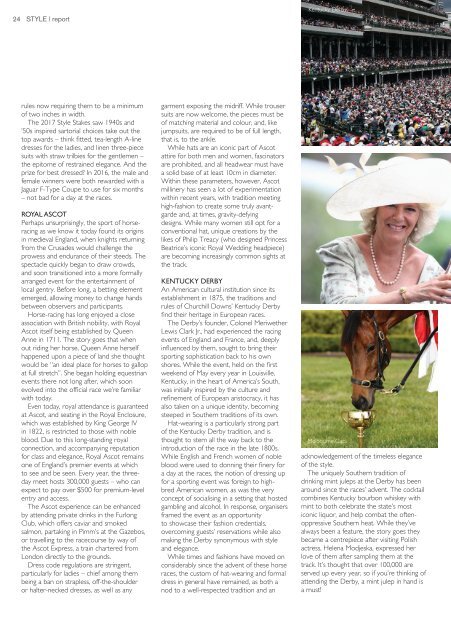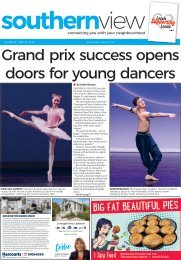Create successful ePaper yourself
Turn your PDF publications into a flip-book with our unique Google optimized e-Paper software.
24 STYLE | report<br />
Kentucky Derby.<br />
rules now requiring them to be a minimum<br />
of two inches in width.<br />
The <strong>2017</strong> <strong>Style</strong> Stakes saw 1940s and<br />
’50s inspired sartorial choices take out the<br />
top awards – think fitted, tea-length A-line<br />
dresses for the ladies, and linen three-piece<br />
suits with straw trilbies for the gentlemen –<br />
the epitome of restrained elegance. And the<br />
prize for best dressed? In 2016, the male and<br />
female winners were both rewarded with a<br />
Jaguar F-Type Coupe to use for six months<br />
– not bad for a day at the races.<br />
ROYAL ASCOT<br />
Perhaps unsurprisingly, the sport of horseracing<br />
as we know it today found its origins<br />
in medieval England, when knights returning<br />
from the Crusades would challenge the<br />
prowess and endurance of their steeds. The<br />
spectacle quickly began to draw crowds,<br />
and soon transitioned into a more formally<br />
arranged event for the entertainment of<br />
local gentry. Before long, a betting element<br />
emerged, allowing money to change hands<br />
between observers and participants.<br />
Horse-racing has long enjoyed a close<br />
association with British nobility, with Royal<br />
Ascot itself being established by Queen<br />
Anne in 1711. The story goes that when<br />
out riding her horse, Queen Anne herself<br />
happened upon a piece of land she thought<br />
would be “an ideal place for horses to gallop<br />
at full stretch”. She began holding equestrian<br />
events there not long after, which soon<br />
evolved into the official race we’re familiar<br />
with today.<br />
Even today, royal attendance is guaranteed<br />
at Ascot, and seating in the Royal Enclosure,<br />
which was established by King George IV<br />
in 1822, is restricted to those with noble<br />
blood. Due to this long-standing royal<br />
connection, and accompanying reputation<br />
for class and elegance, Royal Ascot remains<br />
one of England’s premier events at which<br />
to see and be seen. Every year, the threeday<br />
meet hosts 300,000 guests – who can<br />
expect to pay over $500 for premium-level<br />
entry and access.<br />
The Ascot experience can be enhanced<br />
by attending private drinks in the Furlong<br />
Club, which offers caviar and smoked<br />
salmon, partaking in Pimm’s at the Gazebos,<br />
or travelling to the racecourse by way of<br />
the Ascot Express, a train chartered from<br />
London directly to the grounds.<br />
Dress code regulations are stringent,<br />
particularly for ladies – chief among them<br />
being a ban on strapless, off-the-shoulder<br />
or halter-necked dresses, as well as any<br />
garment exposing the midriff. While trouser<br />
suits are now welcome, the pieces must be<br />
of matching material and colour, and, like<br />
jumpsuits, are required to be of full length,<br />
that is, to the ankle.<br />
While hats are an iconic part of Ascot<br />
attire for both men and women, fascinators<br />
are prohibited, and all headwear must have<br />
a solid base of at least 10cm in diameter.<br />
Within these parameters, however, Ascot<br />
millinery has seen a lot of experimentation<br />
within recent years, with tradition meeting<br />
high-fashion to create some truly avantgarde<br />
and, at times, gravity-defying<br />
designs. While many women still opt for a<br />
conventional hat, unique creations by the<br />
likes of Philip Treacy (who designed Princess<br />
Beatrice’s iconic Royal Wedding headpiece)<br />
are becoming increasingly common sights at<br />
the track.<br />
KENTUCKY DERBY<br />
An American cultural institution since its<br />
establishment in 1875, the traditions and<br />
rules of Churchill Downs’ Kentucky Derby<br />
find their heritage in European races.<br />
The Derby’s founder, Colonel Meriwether<br />
Lewis Clark Jr., had experienced the racing<br />
events of England and France, and, deeply<br />
influenced by them, sought to bring their<br />
sporting sophistication back to his own<br />
shores. While the event, held on the first<br />
weekend of May every year in Louisville,<br />
Kentucky, in the heart of America’s South,<br />
was initially inspired by the culture and<br />
refinement of European aristocracy, it has<br />
also taken on a unique identity, becoming<br />
steeped in Southern traditions of its own.<br />
Hat-wearing is a particularly strong part<br />
of the Kentucky Derby tradition, and is<br />
thought to stem all the way back to the<br />
introduction of the race in the late 1800s.<br />
While English and French women of noble<br />
blood were used to donning their finery for<br />
a day at the races, the notion of dressing up<br />
for a sporting event was foreign to highbred<br />
American women, as was the very<br />
concept of socialising in a setting that hosted<br />
gambling and alcohol. In response, organisers<br />
framed the event as an opportunity<br />
to showcase their fashion credentials,<br />
overcoming guests’ reservations while also<br />
making the Derby synonymous with style<br />
and elegance.<br />
While times and fashions have moved on<br />
considerably since the advent of these horse<br />
races, the custom of hat-wearing and formal<br />
dress in general have remained, as both a<br />
nod to a well-respected tradition and an<br />
Melbourne Cup.<br />
acknowledgement of the timeless elegance<br />
of the style.<br />
The uniquely Southern tradition of<br />
drinking mint juleps at the Derby has been<br />
around since the races’ advent. The cocktail<br />
combines Kentucky bourbon whiskey with<br />
mint to both celebrate the state’s most<br />
iconic liquor, and help combat the oftenoppressive<br />
Southern heat. While they’ve<br />
always been a feature, the story goes they<br />
became a centrepiece after visiting Polish<br />
actress, Helena Modjeska, expressed her<br />
love of them after sampling them at the<br />
track. It’s thought that over 100,000 are<br />
served up every year, so if you’re thinking of<br />
attending the Derby, a mint julep in hand is<br />
a must!


















